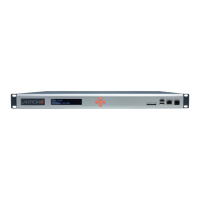6: Basic Parameters
SLC™ 8000 Advanced Console Manager User Guide 90
Remote Subnet(s) One or more allowed subnets behind the remote host, expressed in CIDR
notation (IP address/mask bits). If multiple subnets are specified, the
subnets should be separated by a comma. Up to 10 local subnets
supported.
Configured subnets of the peers may differ, the protocol narrows it to the
greatest common subnet. In IKEv1, this may lead to problems with other
implementations. Make sure to configure identical subnets in such
configurations.
If the remote subnet is not defined, it will be assumed that the remote end of
the connection goes to the remote peer only.
Remote Source IP The internal source IP to use in a tunnel(Virtual IP). Currently the accepted
values are config, CIDR Notation, IP Address Range or poolname. If the
value is config on the responder side, the initiator must propose an address
which is then echoed back. The supported address pools are expressed as
CIDR notation and IP Address range as - or the use of an external IP
address pool using poolname is the name of the IP address pool used for
the lookup.
Local IP Address The IP address of the SLC (local) side of the tunnel, specifically the public-
network interface. If no IP address is given, the value %any will be used in
ipsec.conf (this is the default), signifying an address to be filled in (by
automatic keying) during negotiation. If the SLC initiates the connection
setup the routing table will be queried to determine the correct local IP
address. In case the SLC is responding to a connection setup then any IP
address that is assigned to a local interface will be accepted.
Local Id How the SLC unit should be identified for authentication. The Id is used by
the remote host to select the proper credentials for communicating with the
SLC unit.
Local Hop/Router If the SLC unit is behind a gateway, this specifies the IP address of the
gateway's public network interface. This option is deprecated and is no
longer supported.
Local Subnet(s) One or more subnets behind the SLC unit, expressed in CIDR notation (IP
address/mask bits). If multiple subnets are specified, the subnets should be
separated by a comma. Up to 10 local subnets supported.
Configured subnets of the peers may differ, the protocol narrows it to the
greatest common subnet. In IKEv1, this may lead to problems with other
implementations. Make sure to configure identical subnets in such
configurations.
If the local subnet is not defined, it will be assumed that the local end of the
connection goes to the console manager only.
Local Source IP The internal source IP to use in a tunnel (Virtual IP). Currently the accepted
values are config4, config6 or Valid IP Address. With config4 and config6
an address of the given address family will be requested explicitly. If an IP
address is configured, it will be requested from the responder, which is free
to respond with a different address.

